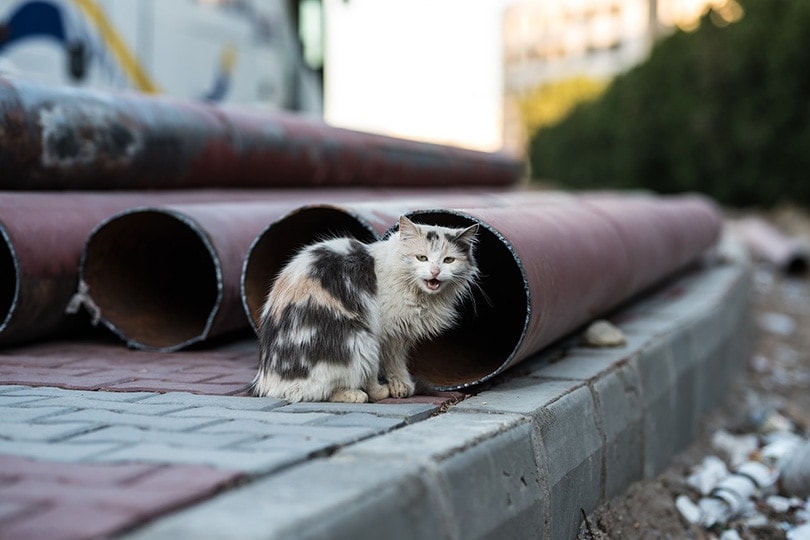9 Surprising Feral Cats Statistics in the US (2024 Update)

Updated on

Click to Skip Ahead
Note: This article’s statistics come from third-party sources and do not represent the opinions of this website.
Cats sure have taken over the world! No, really! When it comes to feral cats, numbers don’t lie. According to statistics, there are a staggering number of feral cats in the US—and they’re only growing with each passing year.
The following statistics highlight just how much of an impact feral cats have on the country and what we need to do to help our furry feline friends. Let’s take a look!
The 9 Feral Cat Statistics in the US
- Around 70 million feral cats roam the wild in the United States.
- A colony of feral cats can range from two to over 200 cats.
- The average lifespan of a feral cat is 2 to 3 years.
- Los Angeles, CA, has the largest feral cat population, with an estimated 1 to 3 million cats.
- Trap Neuter Release helped reduce feral cats by 66%.
- Only 10% of Americans feed feral cats.
- Almost 25% of the feral cat population’s diet is birds.
- Feral cats have reduced the population of 27 species.
- Feral cats can have litters of 12 kittens.

General Feral Cat Statistics and Facts
1. Around 70 million feral cats roam the wild in the United States.
(Advanced Pet Vet)
This is a significant increase from the estimated 44 million cats in 2014. Feral cats are those that have been abandoned or born in the wild and may not be able to survive on their own without human intervention.
The number of feral cats has increased due to a variety of factors, including an increase in pet abandonment and the lack of affordable spay/neuter services.

2. A colony of feral cats can range from two to over 200 cats.
(Tennessee.edu)
The size of a feral cat colony can vary greatly. The main determining factor is access to food. So, if there is an easy food source, the feral cat colony can reach very high numbers. Feral cat colonies usually consist of females, who—if left intact—will continue to have litters, thus increasing the feral cat population.
3. The average lifespan of a feral cat is 2 to 3 years.
(Tennessee.edu)
While a housecat can live between 12 to 20 years, a feral cat only lives a fraction of that: 2 to 3 years. Why is the lifespan so much shorter? Feral cats are more prone to infections that can lead to death. Since they travel to find food or a mate, there is the risk of getting hit by a car. They are also more prone to being attacked by other feral cats or predators.

4. Los Angeles, CA, has the largest feral cat population, with an estimated 1 to 3 million cats.
(KTLA News)
It might be surprising to learn that Los Angeles, California, is home to the most feral cats in the country. Perhaps because the city is so spread out, it is hard to spot a feral cat. However, animal advocates in this city say that LA is an ideal place for feral cats because of the weather and access to food from garbage bins.
Controlling Feral Cat Statistics
5. Trap Neuter Release helped reduce feral cats by 66%.
(AVMA)
Trap Neuter Release (TNR) is a program that helps reduce the number of feral cats in the US. Through TNR, feral cats are trapped, spayed/neutered, vaccinated, and released back into their territory.
This helps control the population and allows them to live without reproducing more kittens. Since its inception, TNR has helped reduce the number of feral cats by an estimated 66% in the US.
Clearly, this program is having a major impact on feral cat populations and should be continued to help keep their numbers from rising again.

6. Only 10% of Americans feed feral cats.
(HumanePro)
Feral cats are very difficult to tame. However, it is not impossible. It starts with getting the feral cat to trust humans.
One way to do this is by feeding feral cats on a regular basis. According to estimates, only 10% of Americans feed feral cats in their neighborhoods.
That number could be increased if more people were educated about the benefits of feeding these animals and how it can help them become tamer and more adoptable.
The US is making progress with the number of feral cats, but there’s still more work to be done.
You can do your part by educating yourself and others about the importance of helping get feral cats accustomed to people and domesticated lifestyles.
Environmental Effects of Feral Cat Statistics
7. About 25% of the feral cat population’s diet is birds.
(HSUS)
While it’s true that cats can be a nuisance to some wildlife, they’re also part of the natural ecosystem. In fact, according to estimates, 25% of the feral cat population’s diet is composed of birds and small rodents.
This helps keep their populations in check and maintain balance in their environment. That being said, it’s still important to keep cats indoors and away from bird habitats.
Protecting wildlife is just as important as helping out the feral cat population.
We need to find a balance between the two that ensures cats can live without hurting the environment and other animals.

8. Feral cats have reduced the population of 27 species.
(Research Gate)
Feral cats have a major impact on their environment. According to research, feral cats have reduced the population of 27 species, most notably birds and small rodents.
This can be a problem for some native species already endangered due to habitat loss or other issues.
That’s why it’s important to practice TNR and implement cat population control measures so feral cats can live in harmony with their environment without harming other species.
It’s also why it’s important to maintain an awareness of their impact on their ecosystems so we can take measures to protect vulnerable wildlife.
9. Feral cats can have litters of 12 kittens.
(International Cat Care)
When it comes to the feral cat population, litter size matters. A single female cat can have litters of around 12 kittens each year, which can quickly add up!
That’s why spaying and neutering is so important when dealing with feral cats. It reduces their reproductive capabilities and helps keep their numbers from exploding out of control.
It also ensures that kittens won’t be born into a life of poverty or struggle. If you see strays in your area, consider rescuing them or taking them to a shelter for help.

Frequently Asked Questions About Feral Cats
Where can I find feral cats?
Feral cats usually inhabit outdoor areas such as parks, abandoned buildings, and alleyways. They are rarely seen in residential neighborhoods.
Are these cats dangerous?
Generally speaking, no. Feral cats are often scared of humans and will usually run away when approached. However, they can become aggressive if they feel threatened or if their food sources are limited. It’s best to leave them alone and not attempt to pet or handle them.

How can I help feral cats in my area?
There are several ways to help feral cats, such as providing food and water, setting up shelters for them to rest in, and getting them spayed or neutered. You can also contact local organizations that specialize in helping feral cats. With your help, we can make a positive difference in the lives of these animals!
Conclusion
The more awareness we have about feral cats, the better we can work together to protect them and help keep their population in check. Right now, the estimated number of feral cats in the US is somewhere around 70 million. That’s a lot of feral cats that could become furry friends!
While it may seem daunting at first, there are ways that we can all contribute to making sure feral cats have a safe and healthy lifestyle. Let’s all do our part to help ensure that feral cats are not only alive but thriving as pets!
Featured Image Credit: Dimitris Vetsikas, Pixabay










